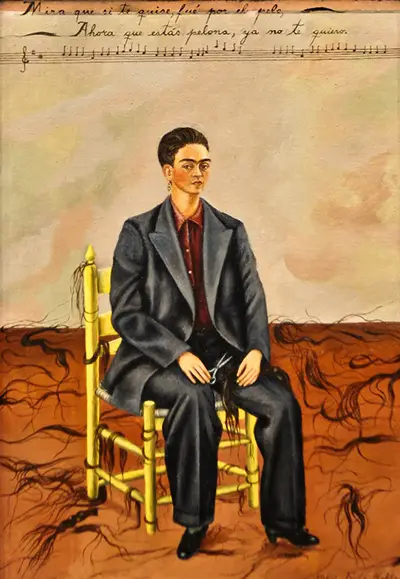The bleak scene conveys distress through tone, action and word.
The artist sits disconsolate among the severed black tresses her husband so loved. They hang from the chair and litter the floor up to the horizon of an indefinite landscape which stretches out around her.
Kahlo was a prolific painter of self-portraiture often depicting herself wearing the richly embroidered and colourful Tehuana dresses’ a traditional Mexican image of womanhood.
Here, in marked contrast to the overt femininity of previous paintings, she is depicted wearing an oversized suit (perhaps Rivera’s) with the cropped hair which indicates her transformation to a harder more independent self where the only concessions to femininity are earrings and the restrained heels.
The dark monotony of the suit and the dun of the landscape add to a feeling of melancholy which pervades the view.
Kahlo is generally associated with the Surrealists and the painting has qualities consistent with that movement.
It is executed in the naive style adopted and favoured by many Surrealists, and there is a sense of dreamlike atmosphere to the scene as the twisting hair seems to become animated, writhing on the ground now it is cut away.
In a feature typical of surrealism there are some appended words. A Mexican lyric runs: ‘Look, if I loved you it was because of your hair. Now that you are without hair, I do not love you anymore.’ This indicates perhaps that we are to read Kahlo’s action as defiance.
If the haircutting comes after the separation, and was the result, not a cause, of the supposed loss of love, then the action was a deliberate rebellion. Perhaps the artist is seeking to claim and possess her new found independence. Yet she is also curiously passive. The scissors lie inert in her hand. We have come upon the scene after her part has ceased, all passion dissipated, leaving only the contemplation of her abstracted glance.
Only the liberated hair appears dynamic.

